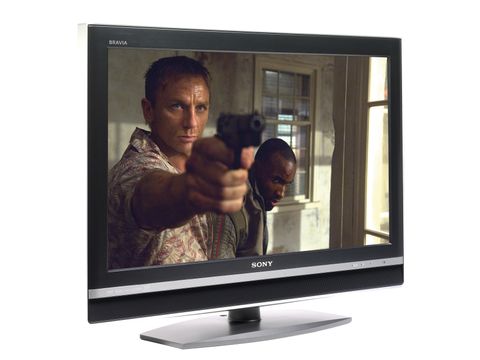TechRadar Verdict
A great LCD performer and really good value - by Sony's standards
Pros
- +
Superb picture quality
Improved connections
Very good value
Cons
- -
Minor flaws in HD pictures
Why you can trust TechRadar
While Sony's recent S and V series of LCD TVs got most things right, we certainly couldn't say that there wasn't room for improvement. And Sony appears to agree with us, for it's just unleashed what looks to all intents and purposes like an update to its original V2000 models, as represented by the 46in KDL-46V2500.
Obviously we need to start this review by covering what makes the 46V2500 different to its 46V2000 predecessor. The most immediately obvious and welcome improvement is the addition on the 46V2500 of a second HDMI, bringing this middle range Bravia set kicking and screaming into the hi-def age.
The second change is less obvious but potentially no less important: a dynamic contrast system that adjusts the backlight output level depending on how dark or bright the TV detects a scene to be. Thanks to this, the 46V2500 is claiming a contrast ratio of 5000:1.
Naturally these new features come on top of all the features previously sported by the 46V2000. These include Sony's Bravia Engine processing aimed at boosting detailing, scaling, colours and black levels (among other things); Sony's SPVA system for boosting the TV's viewing angle; and Sony's Wide Colour Gamut technology, which uses a new phosphor system to deliver a chunk more of the visible colour spectrum than many rival TVs - or, indeed, Sony's own entry-level S Series models.
Aside from the extra HDMI, meanwhile, connectivity remains the same and therefore includes component video inputs, Scarts, a PC interface, and a CAM slot that, as ever, is there to provide subscription channel support to a built-in digital tuner.
The 46V2500 also looks like the 46V2000 - which is no bad thing provided you prefer quiet style to histrionic flashness!
Deep space blacks
And so to our Revenge of the Sith hi-def test movie - and a really very fine performance indeed from the 46V2500. The impact of the dynamic contrast system is immediately felt in the impressive deepness of space that provides the backdrop to the film's opening scene-setting text.
Also quickly catching our eye is the, at times, phenomenal sharpness of the picture, as the 46V2500 reproduces with aplomb every last pixel from particularly detailed shots such as the forest backdrop to the scenes set on Kashyyyk. This isn't a full HD resolution TV, but at times the clarity of its pictures makes you think it might be.
The set's wide colour gamut technology for the most part gives colours a noticeable boost, lending the scenes on the lava planet of Mustafar extra vivacity and impact, yet also making subtle tones look more natural in general than is common in the LCD world. These colour talents actually seem more pronounced on the 46V2500 than they did on the 46V2000, too, thanks to the extra black level competency.
Hard-to-find noise
If you really look for flaws in the 46V2500's images, you can find them. For instance, just occasionally skin tones look slightly waxy; fast motion can smear a touch, especially while watching standard-def, and gentle picture noise can appear with really low quality material.
But ultimately these niggles don't appear nearly frequently enough to seriously tarnish what's overall one of the finest 46in LCD TVs in the business.
Tech.co.uk was the former name of TechRadar.com. Its staff were at the forefront of the digital publishing revolution, and spearheaded the move to bring consumer technology journalism to its natural home – online. Many of the current TechRadar staff started life a Tech.co.uk staff writer, covering everything from the emerging smartphone market to the evolving market of personal computers. Think of it as the building blocks of the TechRadar you love today.

